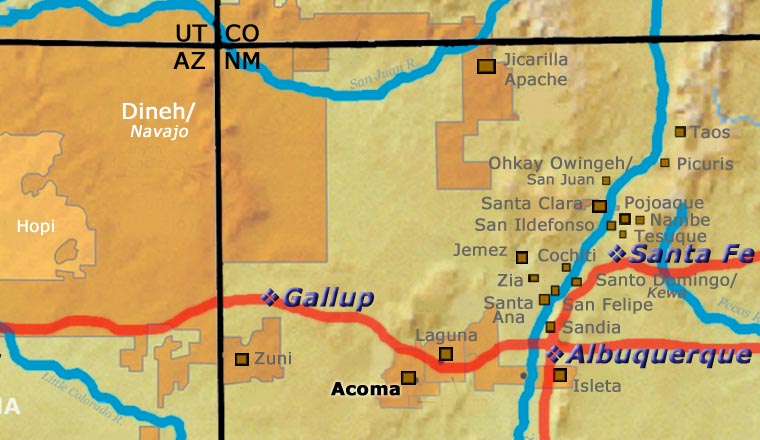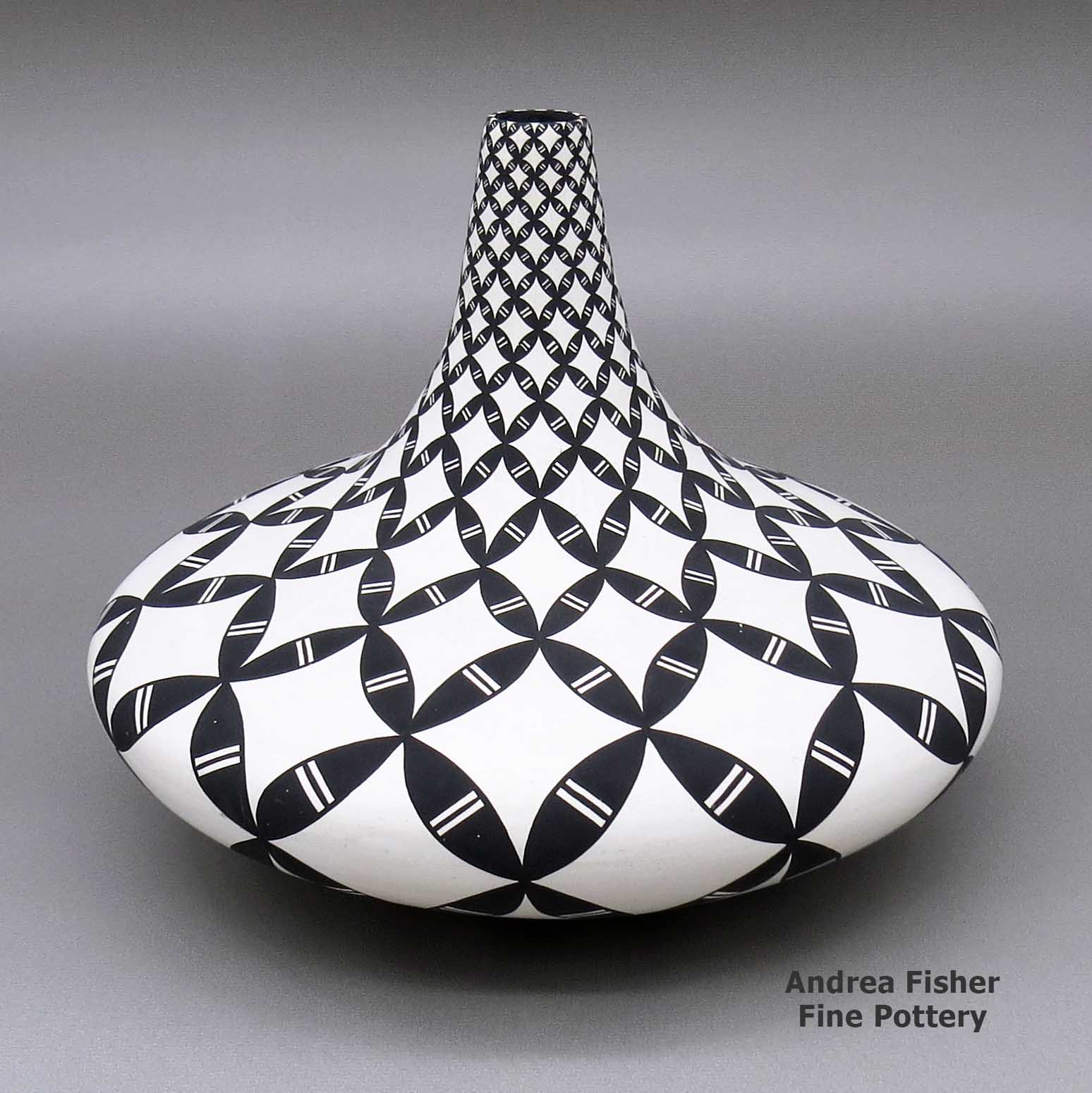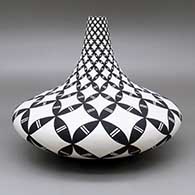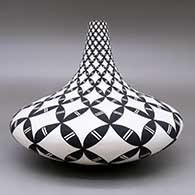
Dorothy Torivio
Acoma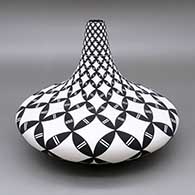
Dorothy Torivio was born at Acoma Pueblo in 1946. She grew up learning to make pottery by watching her mother, Mary Valley, make it. After Dorothy married Peter Concho, her mother-in-law, Lolita Concho, took Dorothy under her wing and completed her education in the traditional art.
Dorothy made traditional polychrome and black-on-white bowls, jars, seed pots, deer, owls and other figures. Dorothy is most known for her innovative seed pots, usually painted with eyedazzling geometric designs. They won her many awards, beginning with a Best of Division, Traditional Pottery at the 1984 SWAIA Santa Fe Indian Market. During that same Indian Market Dorothy was also awarded a 1st Place ribbon in the Traditional Jars category and a 2nd Place ribbon in the Seed Pots category.
In 1997 Dorothy and her pottery were included in Susan Peterson's exhibition at The National Museum of Women in the Arts in Washington, DC.
Dorothy passed her knowledge on to her niece, Sandra Victorino, well before she passed in 2011.
In Andrea's words: "Dorothy Torivio was one of my favorite potters. My most vivid memory of Dorothy occurred in 1997. In the early 1990s, Susan Peterson, a renowned pottery expert, an avid writer, and a skilled potter in her own right, was preparing a hardbound, coffee-table-sized catalog for the National Museum of Women in the Arts. The newly-founded Museum was also preparing an exhibition of the pottery included in Susan's book. Several years before, Dorothy was asked to make three spectacular pieces to be included in both the book and exhibit. Unfortunately, Dorothy failed to make them. Just weeks before Susan's publishing deadline, she asked me to loan the museum the two large pieces I had in the gallery inventory. Pottery by American Indian Women: the Legacy of Generations is the book and the two pieces are on pages 203 and 204.
"When the show finally opened in 1997, a very large celebration was planned. All of the living potters, the donors of pottery to the exhibition, and the principal donors to the museum were invited to Washington DC to celebrate this huge undertaking and beautiful show. As you may recall, many years ago quite a lot of artsy television programs ended with 'This program was brought to you by a grant from Mobil Oil.'' Mobil financed the show, invited all of the potters to DC and produced the opening gala. It was a wonderful experience for the potters because Lou Noto, the then CEO of Mobil, arranged a full-day tour of Washington and the next day included tickets to a Washington Redskins (now Commanders) game. Lou made sure the potters were treated like visiting royalty. The night of the private opening, a gala dinner was held at the museum.
"The museum is a gorgeous building which was built in the late 1800s as a Masonic Temple just several blocks from the White House. The area had fallen into disrepair and had become the eyesore of Washington. The founder of the museum, Mrs. Wilhelmina Holladay, had the foresight to save the beautiful building in the 1980s, completely refurbish it and turn it into something great. The building itself is a symphony of crystal chandeliers and marble the color of Creamsicle ice cream bars. The vast main lobby, with its two massive marble staircases on either side, was the area used to seat over 200 people for the opening night dinner. Since Dorothy was one of the contributing artists, and because I was the person who loaned two of her pieces to the show, we were seated together. It was by far the most gorgeous dining decor that I had ever seen. The round tables were draped with an eggplant-colored tablecloth, covered with a sheer Creamsicle-colored chiffon that shimmered in the candlelight of the room. The centerpiece was a large, flat container filled with small cactus plants, interspersed with apricot-colored roses. There were about six gold-rimmed glasses, gold chargers, white plates with gold edges and enough silverware, that I bet, if it was laid out end-to-end, could have stretched all the way around the Earth. When it was time to take our seats, Dorothy and I stopped and stared in amazement at this overwhelmingly beautiful scene. The massive room, the orange marble, the dark purple and orange, the glittery fabrics, the touches of gold and the candlelight left us both speechless. Considering I grew up in a housing project in Pittsburgh, Pennsylvania, and Dorothy lived in the middle of nowhere in an adobe house in Acoma Pueblo, this was a totally new experience for both of us. We decided that we would pretend that we were fairy tale princesses visiting a king.
"Dorothy seemed to be overwhelmed by all of the glasses and silverware - and so was I. We decided to watch others at the table and, hopefully, the two new princesses could learn. When dinner was finally served, a very handsome young man came and poured us some wine. Dorothy turned to me and said, 'I don’t like wine. Do I have to drink it? I would rather have a beer'. Also, she kept saying 'Who is that guy that is standing behind me?' We finally figured out he was a footman. It was a surprise to see so many footmen at this dinner, and it was the first time I had ever been to an occasion where there was even one. Dorothy kept staring at her wine, wondering if she had to actually drink it. We had a long discussion about who could muster the courage to ask 'our footman' for a beer. I lost, so I turned to this handsome young man and said 'Dorothy would like to have a beer.'' Well, the color quickly drained out of his face. He rushed off towards the room where they were preparing the rest of the meal. We laughed and laughed because we had put a monkey wrench into this well-rehearsed performance. We waited a while, and then we waited a little longer and finally a beer in a beautiful glass arrived for Dorothy. I can only imagine that someone ran full speed to the nearest liquor store to purchase a few bottles just for her. It was a wonderful evening and a beautiful exhibition. Dorothy and I had so much fun laughing about our naïveté, and our inexperience with such luxury. At that point, it became apparent that we were going to be best buddies forever.
"The show traveled to another museum and we were invited to the opening there as well. While we enjoyed the new venue, nothing could have surpassed that incredible experience we had in Washington DC. When the two pots I loaned for the exhibit were finally returned, magically, they found their way to a shelf in my home. Every single time I see them I think of that wonderful evening Dorothy and I spent together playing princess.
"Dorothy passed away in 2011. Derek and I were the only two invited non-natives at her funeral, and we think of her often with much fondness. Her work as an excellent potter, fantastic painter, and lovely person, will always be remembered."
Some Exhibits that featured pieces by Dorothy
- Home: Native People in the Southwest. Heard Museum. Phoenix, Arizona. Opened May 22, 2005
- New Directions in Southwestern Native American Pottery. Peabody Essex Museum. Salem, Massachusetts. November 16, 2001 - March 17, 2002
- The Legacy of Generations: Pottery by American Indian Women. The National Museum of Women in Arts. Washington, DC. October 9, 1997 - January 11, 1998
- The Legacy of Generations: Pottery by American Indian Women. Heard Museum. Phoenix, Arizona. February 14, 1998 - May 17, 1998
- Master Artists of the Southwest. Quintana Galleries. Portland, Oregon. September 24-26, 1993
- Fifth Annual Hollywood Premiere. Four Seasons Hotel. Los Angeles, California. November 23, 1991
- The Perfection of Southwest Pottery. Gallery 10. Scottsdale, Arizona. February 21, 1991
- Our 1990 Indian Market Week Shows. Gallery 10. Santa Fe, New Mexico. August 10-17, 1990
- New Works by Jody Folwell, Dorothy Torivio and Jacquie Stevens. Gallery 10. Scottsdale, Arizona. March 8, 1990
- The Absolute Best of Indian Market. Gallery 10. Four Seasons Hotel. Los Angeles, California. November 18-20, 1989
- Exhibition of Richard Zane Smith, Dorothy Torivio, LuAnn Tafoya and Thomas Natseway. Gallery 10. Scottsdale, Arizona. March 2-8, 1989
- Individual Statements of Style. Gallery 10. Scottsdale, Arizona. February 25, 1988
- The Best of Indian Market '87: Six Nationally Prominent Native American Artists. Four Seasons Hotel. Los Angeles, California. November 28-29, 1987
- Exhibition of Richard Zane Smith, Dorothy Torivio, Polly Folwell and Fred Myers. Gallery 10. Scottsdale, Arizona. February 5-17, 1987
- Innovators in Southwestern Native American Ceramics. Gallery 10. Scottsdale, Arizona. February 6-19, 1986
- Jewels of the Southwest. Gallery 10. Scottsdale, Arizona. December 3, 1985 - January 4, 1986
- The Pottery of Jody Folwell and Grace Medicine Flower, with "Rising Stars" including Dorothy Torivio & Richard Zane Smith, potters. Morning Star Gallery. Santa Fe, New Mexico. August 12-17, 1985
Some Awards Won by Dorothy
- 2004 Heard Museum Guild Indian Fair & Market, Classification VIII - Pottery, Division A - Traditional/Native clay/hand (painted): Best of Division
- 1998 Santa Fe Indian Market, Classification II - Pottery, Division F - Traditional pottery, painted designs on matte or semi-matte surface, all forms except jars, Category 1302 - Seed bowls (over 7" in diameter): First Place
- 1995 Santa Fe Indian Market, Classification II - Pottery, Division G - Traditional pottery, painted designs on matte or semi-matte surface, all forms except jars, Category 1402 - Seed bowls (over 7" in diameter): Second Place
- 1994 Santa Fe Indian Market, Classification II - Pottery, Division G - Traditional pottery, painted designs on matte or semi-matte surface, all forms except jars, Category 1402 - Seed bowls (over 7" in diameter): First Place
- 1994 Santa Fe Indian Market, Classification II - Pottery, Division G - Traditional pottery, painted designs on matte or semi-matte surface, all forms except jars, Category 1406 -Other vases: Second Place
- 1984 Santa Fe Indian Market, Classification II - Pottery, Division F - Traditional pottery, painted designs on matte or semi-matte surface: Best of Division. Awarded for jar
- 1984 Santa Fe Indian Market, Classification II - Pottery, Division F - Traditional pottery, painted designs on matte or semi-matte surface, Category 1202 - Jars, Acoma or Laguna: First Place
- 1984 Santa Fe Indian Market, Classification II - Pottery, Division F - Traditional pottery, painted designs on matte or semi-matte surface, Category 1205 - Seed bowls: Second Place
- 1984 Heard Museum Guild Native American Invitational Arts Show: Best of Pottery Award. Awarded for artwork: Large Brown Jar
- 1984 Heard Museum Guild Native American Invitational Arts Show: Judge's Choice Award - Dennis Lyons. Awarded for artwork: Small Seed Jar
- 1984 Heard Museum Guild Native American Invitational Arts Show: Judge's Choice Award - Clara Lee Tanner. Awarded for artwork: Small Seed Jar
- 1984 Heard Museum Guild Native American Invitational Arts Show, Classification II - Pottery, Division A - Traditional Construction and Firing Method: First Place. Awarded for artwork: Large Brown Jar
- 1984 Heard Museum Guild Native American Invitational Arts Show, Classification II - Pottery, Division D - Miniatures (Under 2 1/4"): First Place. Awarded for artwork: Miniature Seed Jar
- 1987 Gallup InterTribal Indian Ceremonial, Category VI - Pottery, Jar, Seed Jar: Second Place
- 1987 Gallup InterTribal Indian Ceremonial, Category VI - Pottery, Decorated, any object: First Place
100 West San Francisco Street, Santa Fe, New Mexico 87501
(505) 986-1234 - www.andreafisherpottery.com - All Rights Reserved

Acoma Pueblo
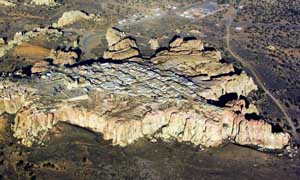
Sky City
According to Acoma oral history, the sacred twins led their ancestors to "Ako," a magical mesa composed mostly of white rock, and instructed those ancestors to make that mesa their home. Acoma Pueblo is called "Sky City" because of its position atop the mesa. Acoma is located about 60 miles west of Albuquerque.
Acoma, Old Oraibi (at Hopi) and Taos all lay claim to being the oldest continuously inhabited community in the U.S. Those competing claims are hard to settle as each village can point to archaeological remnants close by to substantiate each village's claim. While the people of Acoma have an oral tradition that says they've been living in the same area for more than 2,000 years, archaeologists feel more that the present pueblo was established near the end of the major migrations of the 1300s. The location is essentially on the boundary between the Mimbres-Mogollon and Ancestral Puebloan cultures. Each of those cultures has had an impact on the styles and designs of Acoma pottery, especially since modern potters have been getting the inspiration for many of their designs from ancient pot shards they have found while walking on pueblo lands.
Francisco Vasquez de Coronado ascended the cliff to visit Acoma in 1540. He afterward wrote that he "repented having gone up to the place." But the Spanish came back later and kept coming back. In 1598 relations between the Spanish and the Acomas took a really bad turn with the arrival of Don Juan de Oñaté and the soldiers, settlers and Franciscan monks that accompanied him. After ascending to the mesa top, Oñaté decided to force the Acomas to swear loyalty to the King of Spain and to the Pope. When the Acomas realized what the Spanish meant by that, a group of Acoma warriors attacked a group of Spanish soldiers and killed 11 of them, including one of Oñaté's nephews. Don Juan de Oñaté retaliated by attacking the pueblo, burning most of it and killing more than 600 people. Another 500 people were imprisoned by the Spanish, males between the ages of 12 and 25 were sold into slavery and 24 men over the age of 25 had their right foot amputated. Many of the women over the age of 12 were also forced into slavery and were eventually parceled out among Catholic convents in Mexico City. Two Hopi men were also captured at Acoma and, after having one hand cut off, they were released and sent home to spread the word about Spain's resolve to subjugate the inhabitants of Nuevo Mexico.
When word of the massacre and the punishments meted out got back to King Philip in Spain, he banished Don Juan de Oñaté from Nuevo Mexico. Some Acomas had escaped that fateful Spanish attack and returned to the mesa top in 1599 to begin rebuilding. In 1620 a Royal Decree was issued which established civil offices in each pueblo and Acoma had its first governor appointed. By 1680, the situation between the pueblos and the Spanish had deteriorated again to the point where the Acomas were extremely willing participants in the 1680 Pueblo Revolt.
After the successful Pueblo Revolt the Spanish retreated back to Mexico. Refugees from other pueblos began to arrive at Acoma, fearing an eventual Spanish return and reprisals. That strained the resources of Acoma until the Spanish actually did return. The residents of the pueblo had to make a hard decision. Many of the refugees chose to try a peaceful solution: they quickly relocated to the ancient Laguna area and made peace with the Spanish as soon as they appeared in the region.
Over the next 200 years, Acoma suffered from breakouts of smallpox and other European diseases to which they had no immunity. At first they sided with the Spanish against nomadic raiders from the Ute, Apache and Comanche tribes. Then New Mexico changed hands, the railroads arrived and Acoma became dependent on goods brought in from the outside world.
For many years the villagers had been content on the mesa top. Now most live in villages on the valley floor where water, electricity and other necessities are easily available. While a few families still make their permanent home on the mesa top, the old pueblo is used almost exclusively for ceremonies and celebrations these days.
It's the dense, slate-like clay, that allows Acoma pottery to be thin, lightweight and durable. After they form a pot, they paint it with a white slip. Once dry, black and red design motifs are added using mineral and plant derived paints. Fine lines, geometrics, parrots and old Mimbres designs are common motifs. The traditional paintbrush is chewed from the yucca leaf. Historically, Acoma was known for large, thin-walled "ollas," jars used for storing food and water. With the arrival of the railroad and tourists in the 1880s, Acoma potters adapted the size, shapes and styles of their pots in order to appeal to the new buyers.
Acoma potters felt it was an inappropriate display of ego to sign a pot up into the mid-1960s. Then Lucy Lewis, Jessie Garcia and Marie Z. Chino started signing their pots. The 1960s is also a time when the primary Acoma white clay vein passed through a layer of widely distributed impurities, impurities that passed through the clay filtering process and showed up only during and after the firing. The problem was so bad it affected virtually every Acoma potter and every pot they made. Thankfully, by the late 1960s they had dug through that layer of clay and into a deeper layer that didn't have the problem.
100 West San Francisco Street, Santa Fe, New Mexico 87501
(505) 986-1234 - www.andreafisherpottery.com - All Rights Reserved

Acoma
$ SOLD
gmac4a123
Black-on-white jar with a geometric design
8.5 in L by 8.5 in W by 6.75 in H
Condition: Very good, rubbing on bottom and minor pitting
Signature: Dorothy Torivio Acoma, N.M.
100 West San Francisco Street, Santa Fe, New Mexico 87501
(505) 986-1234 - www.andreafisherpottery.com - All Rights Reserved

Teofila Torivio Family Tree
Disclaimer: This "family tree" is a best effort on our part to determine who the potters are in this family and arrange them in a generational order. The general information available is questionable so we have tried to show each of these diagrams to living members of each family to get their input and approval, too. This diagram is subject to change should we get better info.
- Teofila Torivio & Antonio Torivio
- Lolita Concho (1914-2000)
- Dorothy Torivio (daughter-in-law) (1946-2011)
- Sandra Victorino (niece) (1958-) & Cletus Victorino Sr.
- Cletus Victorino Jr. (1978-)
- Sandra Victorino (niece) (1958-) & Cletus Victorino Sr.
- Dorothy Torivio (daughter-in-law) (1946-2011)
- Concepcion "Connie" Torivio Garcia (c. 1925-)
- Juanita Torivio Keene & Gus Keene Sr.
- Adrienne Roy Keene
- Gus Keene Jr.
- Waya Gary Keene
- Mamie Torivio Ortiz & Joe L. Ortiz
- Rachel Arnold (1930-)
- Myrna Antonio Chino (c.1930s-) & Elmer Chino
- C. Maurus Chino (1954-)
- Darlene Chino
- Debbie Chino
- Keith Chino (1960-)
- Larry Antonio Chino (1958-)
- Paula Chino
- Linda Juanico (1927-)
- Carmen King
- Frances Pino Torivio (1905-)
- Wanda Aragon (1948-) & Marvis Aragon Sr.
- Clarise Marie Aragon (1972-)
- Marvis Aragon Jr. & Delores Aragon (daughter-in-law) (1969-)
- Ruth Paisano
- Lilly Maria Salvador (1944-) & Wayne Salvador
- Carleen Salvador
- Darlene Salvador
- Roberta Salvador
- Ryan Paul Salvador
- Wanda Aragon (1948-) & Marvis Aragon Sr.
Some of the above info is drawn from Southern Pueblo Pottery, 2000 Artist Biographies, by Gregory Schaaf, © 2002, Center for Indigenous Arts & Studies. Other info is derived from personal contacts with family members and through interminable searches of the Internet and cross-examination of the data found.
(505) 986-1234 - www.andreafisherpottery.com - All Rights Reserved


